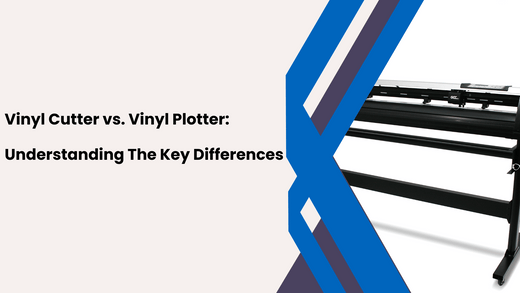In custom design, signage, and crafting, terms like "vinyl cutter" and "vinyl plotter" are often used interchangeably. However, crucial differences between these two machines can impact how you approach your projects, whether you're making intricate decals, custom T-shirts, or large-scale banners.
Choosing between a vinyl cutter and a vinyl plotter depends on the specifics of your project, the level of precision required, and the materials you're working with.
In this comprehensive guide, we will explore the vinyl cutter vs vinyl plotter debate by diving into what each machine is, how they work, their fundamental differences, and which one might best suit your needs.
What Is a Vinyl Cutter?

A vinyl cutter is designed to cut shapes, letters, or designs from thin, adhesive-backed vinyl sheets. It uses a sharp blade to cut the material based on a digital design loaded into the machine's software. Vinyl cutters are typically used in crafting, garment decoration, sign-making, and decal production.
How a Vinyl Cutter Works
A vinyl cutter feeds vinyl through the machine while a small blade moves in the X and Y directions to cut the design. The machine is driven by software that sends the design file to the cutter, usually in formats like SVG or AI. The blade doesn't entirely cut through the backing paper, allowing you to weed out the excess vinyl and apply the design using transfer tape.
Vinyl cutters are most commonly used for:
- Crafting and hobby projects like custom stickers and decals
- T-shirt and apparel decoration using heat transfer vinyl (HTV)
- Signage for both indoor and outdoor use
- Vehicle decals and small-scale graphics
Advantages of Vinyl Cutters
- Precision for Small Designs: Vinyl cutters excel at cutting intricate designs and fine details, making them ideal for small decals, letters, and logos.
- Easy to Use: Most vinyl cutters are user-friendly, with accessible software, making them an excellent option for beginners and hobbyists.
- Compact and Affordable: Vinyl cutters are relatively compact and affordable compared to larger machines, making them a practical choice for small businesses or personal use.
- Versatile Material Compatibility: Vinyl cutters can handle a variety of materials, including adhesive vinyl, heat transfer vinyl (HTV), cardstock, and even some thin fabrics.
Limitations of Vinyl Cutters
- Limited Size: Most vinyl cutters have a maximum cutting width of around 12 to 24 inches, making them less suitable for large projects.
- No Printing Capability: Vinyl cutters are strictly cutting machines. They do not print designs, so a separate printer is required for full-color prints.
What Is a Vinyl Plotter?

A vinyl plotter, sometimes called a cutting plotter, is a giant machine that cuts vinyl and can draw designs using pens or other tools. Vinyl plotters, such as signage, banners, and vehicle wraps, are typically used in commercial environments for large-scale projects.
How a Vinyl Plotter Works
Like vinyl cutters, vinyl plotters use a blade to cut designs into vinyl. However, plotters are larger and often more sophisticated, allowing for more complex and larger designs. In addition to cutting, some plotters can draw with pens, making them useful for technical drawings or patterns. The cutting bed is wider, with most plotters handling material widths of 24 inches or more.
Vinyl plotters are commonly used for:
- Large-scale signage like storefront displays, banners, and billboards
- Vehicle wraps for cars, trucks, and boats
- Architectural signage for buildings or construction sites
- Cutting patterns for industrial applications
Advantages of Vinyl Plotters
- Larger Cutting Area: Vinyl plotters are designed for more significant projects, with cutting widths often exceeding 24 inches. This makes them ideal for vehicle wraps, large signage, and other large-scale applications.
- Dual Functionality: Some vinyl plotters can also plot (draw) designs, making them more versatile than standard vinyl cutters.
- Greater Precision for Large Designs: Vinyl plotters can cut large designs with precision, ensuring accuracy for projects requiring significant attention to detail over a wide surface area.
Limitations of Vinyl Plotters
- Higher Cost: Vinyl plotters are generally more expensive than vinyl cutters, making them less accessible for hobbyists or small businesses.
- Complexity: Vinyl plotters are typically more complex to set up and operate, requiring more technical know-how and experience.
- Larger Footprint: Vinyl plotters take up more space due to their size, which may be a drawback for small workspaces.
Vinyl Cutter vs. Vinyl Plotter: Key Differences
Now that we've established what each machine does let's examine the critical differences between a vinyl cutter and a vinyl plotter to help you determine which machine suits your needs.
- Size and Cutting Area
- Vinyl Cutters typically have a smaller cutting width, ranging from 12 to 24 inches. These machines are compact and suitable for smaller projects like custom decals, stickers, and heat transfer designs.
- Vinyl Plotter: Designed for larger projects, vinyl plotters offer a wider cutting area, often starting at 24 inches and going up to 60 inches or more. This makes them ideal for large signage, vehicle wraps, and banners.
- Cutting Precision
- Vinyl Cutter: Vinyl cutters are known for their precision, particularly for intricate designs with small details. If you need to cut fine text, logos, or small decals, a vinyl cutter excels in this area.
- Vinyl Plotter: While vinyl plotters offer excellent precision, they are better suited for larger designs. They can handle intricate cuts but are optimized for larger-scale projects.
- Material Compatibility
- Vinyl Cutter: Vinyl cutters can handle a variety of materials, but their cutting force is generally lower than that of a vinyl plotter. They work well with adhesive vinyl, heat transfer vinyl (HTV), and other thin materials.
- Vinyl Plotter: Vinyl plotters have more powerful motors and cutting blades, allowing them to handle thicker materials like reflective vinyl, sandblast masks, and other industrial materials.
- Cost and Accessibility
- Vinyl Cutter: Vinyl cutters are more affordable, ranging from $200 to $500 for hobbyist models and up to $1,500 for more advanced options. This makes them accessible for personal use and small businesses.
- Vinyl Plotter: Vinyl plotters are significantly more expensive, often starting at $1,500 and going well beyond $3,000 for professional-grade models. This higher cost reflects their advanced capabilities and larger cutting areas, making them more suitable for commercial applications.
- Application and Use Case
- Vinyl Cutters are best suited for hobbyists, small businesses, and anyone working on smaller, more detailed projects like decals, stickers, and custom T-shirts. They are also great for those who need portability or have limited workspace.
- Vinyl Plotter: This tool is ideal for professionals who need to create large-scale designs such as vehicle wraps, signage, and industrial applications. Vinyl plotters are the go-to for print shops, sign-making businesses, and large production environments.
Vinyl Cutter vs. Vinyl Plotter: Which One Should You Choose?
Choosing between a vinyl cutter and a vinyl plotter depends mainly on the type of work you plan to do. Below, we'll guide you on which machine best suits different users and applications.
- For Hobbyists and Small Businesses
Suppose you're a hobbyist or a small business owner looking to create custom decals, stickers, T-shirts, or smaller signs. In that case, a vinyl cutter is likely the best choice. It's compact, affordable, and easy to use, offering plenty of precision for detailed designs. Machines like the GCC Expert II-24 or the Saga 720I are excellent options for these users.
- For Large-Scale Signage and Vehicle Wraps
A vinyl plotter is the better option if you're working on large projects like vehicle wraps, banners, or commercial signage. The increased cutting width and power allow you to easily handle more oversized materials and more complex jobs. Machines like the GCC Jaguar V LX or the Saga 1350I are built for these demanding applications, offering high precision over large cutting areas.
- For Industrial Applications
A vinyl plotter is essential for industrial applications that require cutting through thicker or more durable materials like reflective vinyl or sandblast stencils. These machines are built to handle tough materials and provide the durability and power needed for such tasks.
Top Vinyl Cutters and Vinyl Plotters on the Market
Here are some of the best options for both vinyl cutters and vinyl plotters from top brands like GCC and Saga:
Vinyl Cutters:
- GCC Expert II-24: An excellent vinyl cutter for small businesses and hobbyists, offering 24-inch cutting width and high precision.
- Saga 720I: A versatile cutter with a 28-inch cutting width, perfect for medium-sized projects and detailed designs.
Vinyl Plotters:
- GCC Jaguar V LX: A professional-grade vinyl plotter with a 24-inch cutting width designed for large-scale projects like vehicle wraps and signage.
- Saga 1350I: A powerful plotter with a 53-inch cutting width, ideal for large banners, vehicle wraps, and industrial applications.
Conclusion
In the battle of vinyl cutter vs vinyl plotter, the right choice depends on your project's size and complexity, budget, and workspace. Vinyl cutters are perfect for hobbyists, crafters, and small businesses working on smaller, detailed projects like decals and T-shirts. On the other hand, vinyl plotters are the go-to machines for professionals working on large-scale designs, vehicle wraps, and industrial signage.
By understanding the critical differences between these machines, you can make an informed decision and invest in the right equipment to meet your needs. Whether you choose a vinyl cutter or a plotter, you'll be well on your way to producing high-quality, custom designs that stand out.

